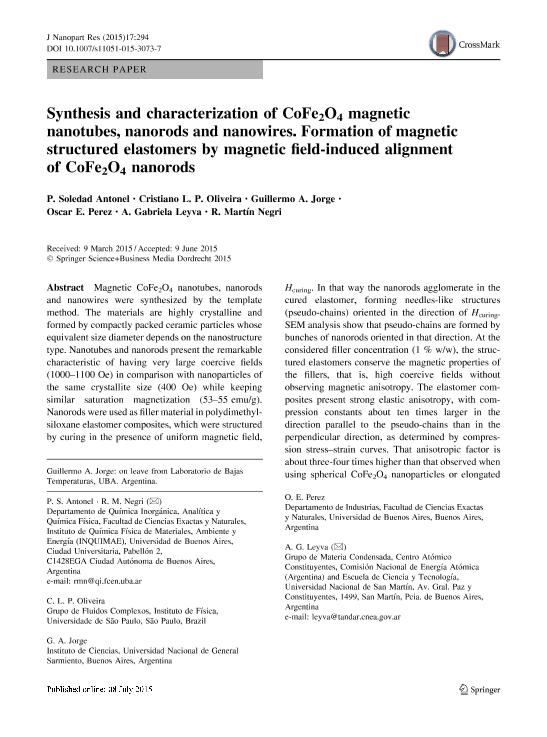Artículo
Synthesis and characterization of CoFe2O4 magnetic nanotubes, nanorods and nanowires. Formation of magnetic structured elastomers by magnetic field-induced alignment of CoFe2O4 nanorods
Antonel, Paula Soledad ; Oliveira, Cristiano L. P.; Jorge, Guillermo Antonio
; Oliveira, Cristiano L. P.; Jorge, Guillermo Antonio ; Perez, Oscar Edgardo
; Perez, Oscar Edgardo ; Leyva de Guglielmino, Ana Gabriela; Negri, Ricardo Martin
; Leyva de Guglielmino, Ana Gabriela; Negri, Ricardo Martin
 ; Oliveira, Cristiano L. P.; Jorge, Guillermo Antonio
; Oliveira, Cristiano L. P.; Jorge, Guillermo Antonio ; Perez, Oscar Edgardo
; Perez, Oscar Edgardo ; Leyva de Guglielmino, Ana Gabriela; Negri, Ricardo Martin
; Leyva de Guglielmino, Ana Gabriela; Negri, Ricardo Martin
Fecha de publicación:
06/2015
Editorial:
Springer
Revista:
Journal of Nanoparticle Research
ISSN:
1388-0764
e-ISSN:
1572-896X
Idioma:
Inglés
Tipo de recurso:
Artículo publicado
Clasificación temática:
Resumen
Magnetic CoFe2O4 nanotubes, nanorods and nanowires were synthesized by the template method. The materials are highly crystalline and formed by compactly packed ceramic particles whose equivalent size diameter depends on the nanostructure type. Nanotubes and nanorods present the remarkable characteristic of having very large coercive fields (1000-1100 Oe) in comparison with nanoparticles of the same crystallite size (400 Oe) while keeping similar saturation magnetization (53-55 emu/g). Nanorods were used as filler material in polydimethylsiloxane (PDMS) elastomer composites, which were structured by curing in the presence of uniform magnetic field, Hcuring. In that way the nanorods agglomerate in the cured elastomer, forming needles-like structures (pseudo-chains) oriented in the direction of Hcuring. SEM analysis show that pseudo-chains are formed by bunches of nanorods oriented in that direction. At the considered filler concentration (1 % w/w), the structured elastomers conserve the magnetic properties of the fillers, that is, high coercive fields without observing magnetic anisotropy. The elastomer composites present strong elastic anisotropy, with compression constants about ten times larger in the direction parallel to the pseudo-chains than in the perpendicular direction, as determined by compression stress-strain curves. That anisotropic factor is about three-four times higher than that observed when using spherical CoFe2O4 nanoparticles or elongated Ni nanochains. Hence, the use of morphological anisotropic structures (nanorods) results in composites with enhanced elastic anisotropy. It is also remarkable that the large elastic anisotropy was obtained at lower filler concentration compared with the above mentioned systems (1 % w/w vs. 5-10 % w/w).
Archivos asociados
Licencia
Identificadores
Colecciones
Articulos(INQUIMAE)
Articulos de INST.D/QUIM FIS D/L MATERIALES MEDIOAMB Y ENERGIA
Articulos de INST.D/QUIM FIS D/L MATERIALES MEDIOAMB Y ENERGIA
Articulos(IQUIBICEN)
Articulos de INSTITUTO DE QUIMICA BIOLOGICA DE LA FACULTAD DE CS. EXACTAS Y NATURALES
Articulos de INSTITUTO DE QUIMICA BIOLOGICA DE LA FACULTAD DE CS. EXACTAS Y NATURALES
Articulos(SEDE CENTRAL)
Articulos de SEDE CENTRAL
Articulos de SEDE CENTRAL
Citación
Antonel, Paula Soledad; Oliveira, Cristiano L. P.; Jorge, Guillermo Antonio; Perez, Oscar Edgardo; Leyva de Guglielmino, Ana Gabriela; et al.; Synthesis and characterization of CoFe2O4 magnetic nanotubes, nanorods and nanowires. Formation of magnetic structured elastomers by magnetic field-induced alignment of CoFe2O4 nanorods; Springer; Journal of Nanoparticle Research; 17; 294; 6-2015; 294-308
Compartir
Altmétricas
Items relacionados
Mostrando titulos relacionados por título, autor y tema.
-
Lavorato, Gabriel Carlos ; Fiore, G.; Tiberto, P.; Baricco, M.; Sirkin, Hugo Ricardo Mario ; Moya, J.A (Elsevier Science, 2012-09)
-
Paul, Amitesh; Esquinazi, Pablo D.; Zandalazini, Carlos Ivan ; Setzer, Annette; Knolle, Wolfgang (Elsevier Science, 2023-01)
-
Pili, Lucas ; Grigera, Santiago Andrés (American Physical Society, 2019-04-23)



